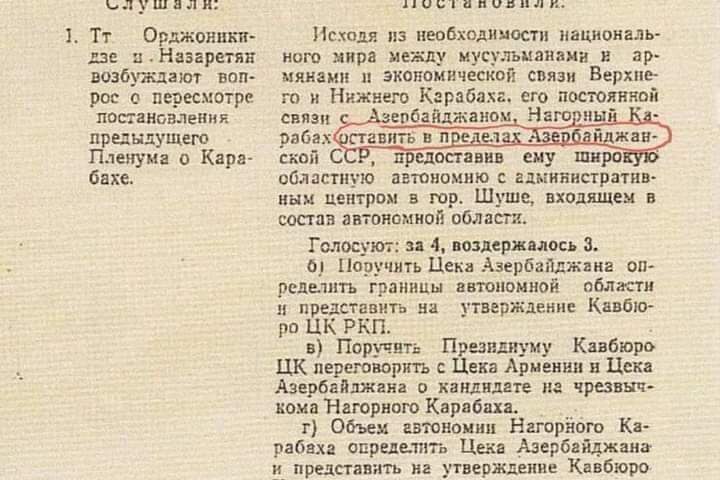Lull before the storm… As a result of carnage, which occurred twice in the first quarter of the XX century (1905-1906, 1918-1920), even by approximate calculations, about two million Azeris were killed or became refugees. But after November 1920 after fall of dashnak government in Armenia, Azeris began gradually to return the land of their ancestors, forgot past hostilities, began to live in neighborhood with Armenians and work peacefully together with them. And if in 1920 only 10,000 Azeris were left in the whole Armenia, then in 1922 together with the returned refugees they numbered 77,767, and by 1931 – 105,838 people.[30]
New period had new requirements. The question of resettlement of Azeris in their native lands and their social-cultural development was drawn to the first plan during the first years of the Soviet rule. The decree signed by the chairman of the People’s Commissars’ Soviet Sarkis Kasayan said that in the areas, where live Armenians the official language should be considered Armenian, in the areas where live Azeris – Turkish [Azeri]. In the areas with compact Azeri population in Amasya, Basarkecher, Vedi, Karabaklar, Zangibasar, Krasnoselsk regions the Azeri language was the official language. Until 1953, that is before massive deportation of Azeris, the key governmental positions of these regions- the first secretaries of the district committee (raikom) and chairmen of the executive committee (ispolkom) belonged to those of Azeri nationality, among them Ibish Abbasov, Jafar Velibekov, Rza Velibekov, Rza Rzayev, Ali Mamedov, Husein Mamedov, Talib Musayev, Hasham Shahbazov, Gulmamed Mamedov and others.In the regions of mixed inhabitance of Azeris and Armenians in Kafan, Echmiadzin, Yekhegnadzor, Azizbekov, Kalinin, Mehri, Sisyan, Stepanavan, Idjevan, there was an unvoiced order, which said that one of the secretaries of the district committee or the chairman of the executive committee or his deputy should be Azeri by nationality.
There were many Azeris in the leading positions in the executive and party organs in the Republic of Armenia at that time. Among them were the chairman of the commission on the national minorities under the Central Executive Committee, deputy of the people’s commissar [minister] of the Internal Affairs Bala Effendiyev, secretary of the Party Central Committee Mamed Iskenderov, chief of the propaganda and agitation department of the Party Central Committee Akber Rzayev, first deputy of the Chairman of the Soviet of the Ministers Rza Velibekov, minister of Justice of the republic Safar Almamedov, minister of the social aid Ali Tagizade, chief of the roads administration Husein Abdullayev and others. 12-18 deputies Azeris participated in all the sessions of the Supreme Soviet.
In all the villages where Azeris lived schools, clubs, and libraries and in some villages even kindergartens were opened. Teaching specialists were trained in the pedagogical colleges and institutes opened in Yerevan.
Beginning from 1925 the publishing houses of the Central Committee of the Communist Party (CCCP) of Armenia, the Yerevan city party committee, the Central Executive Committee, Ministry of Agriculture and Ministry of Justice issued books in Azeri along with Armenian as well. In Yerevan beginning from 1921 republican newspapers in Azeri language became to be published, among them, «Randjbar», «Zangi», «Gizil Shafag», «Communist», «Sovet Ermenistani», own regional newspapers were published in six regions with Azeri majority (Amasya, Basarkecher, Vedi, Karabaklar, Zangibasar, Krasnoselsk) and yet in other eight regions the regional newspapers were translated into Azeri language.
In 1922 the Azeri theatre, which existed in Yerevan (then Erivan) since 1882 reestablishes and from 1926 it obtains the official status of the State Dramatic Theatre. In 1940 this theatre becomes the All-Union Shakespeare contest laureate for its staging of «Othello».
But this armistice didn’t last long. After Armenia was granted the primordial Azeri lands in 1920 – the Basarkecher region (okrug) of the Yeni Bayazid district of the Erivan province, the Vedibasar region of the Erivan province and Zangezur district of the Ganje province (total area – 9800 sq km), Armenians’ appetites flared up again. After end of World War II in November 1945 the first secretary of the CC CP of Armenia G. Arutyunov in his letter to Stalin raises the question of Mountainous Karabakh again demanding transfer of this territory to Armenia. Stalin passed this letter to Malenkov. He, in his turn sent it to the Azeri leadership for response. Mir Jafar Bagirov, the Azeri leader of that time, replied to this letter in a quite witty way: «Azerbaijan doesn’t mind this suggestion providing that the territories, which borders with it in the Armenian SSR, Georgian SSR and Dagestan ASSR, which are the primordial Azeri lands and where the majority of the local population is Azeris to be returned to Azerbaijan». This response put an end to the further discussion of Arutyunov’s «suggestion».
Not satisfied with this, Armenian leadership began to weave new intrigues trying to make Armenia a mono-national state. As we see further, one of the results of these intrigues became forceful deportation of Azeris from Armenia.




